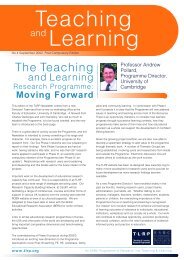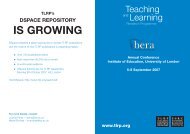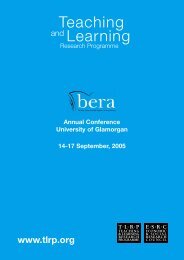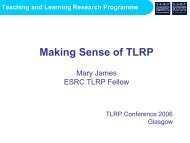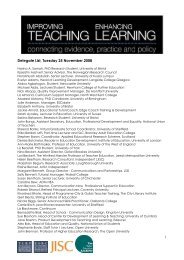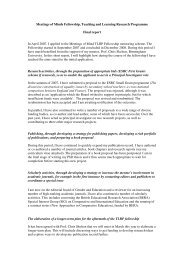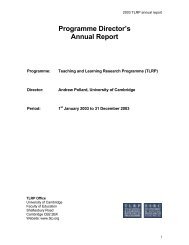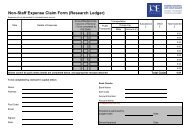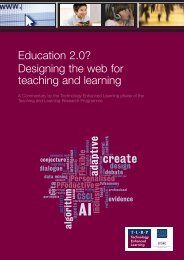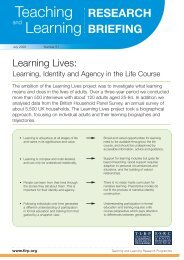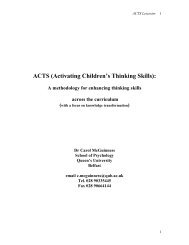GETTY IMAGES24 EARLY YEARSHow do we begin?Giving children the right start makes a big differenceThe EPPE project hasrobustly dem<strong>on</strong>strated theimportance ofhigh-quality pre-school inchildren’s intellectual andsocial development. It haspinpointed what makes good preschoolteaching, what makes a goodcentre and what difference parentscan make.Its findings have been instrumentalin formulating the Sure Startprogramme as well as governmentguidance for early years curricula.Teaching: good <str<strong>on</strong>g>practice</str<strong>on</strong>g>Most important forearly-years teachers is that,through careful studyof settings which weremeasurably successful,EPPE found that there wereseven characteristics ofeffective provisi<strong>on</strong>.They are:sustained sharedthinkingHigh-quality interacti<strong>on</strong>between adult and childor between two childrenrequires <strong>on</strong>e-<str<strong>on</strong>g>to</str<strong>on</strong>g>-<strong>on</strong>e workbetween two individuals, orhighly focussed group work.Both or all participants mustjoin in, working <str<strong>on</strong>g>to</str<strong>on</strong>g>gether<str<strong>on</strong>g>to</str<strong>on</strong>g> solve a problem, extenda s<str<strong>on</strong>g>to</str<strong>on</strong>g>ry or carry out someother intellectual activity.Allied <str<strong>on</strong>g>to</str<strong>on</strong>g> this is open-endedquesti<strong>on</strong>ing from staff <str<strong>on</strong>g>to</str<strong>on</strong>g>children.initiati<strong>on</strong> of activitiesIn good provisi<strong>on</strong>,children and adults eachsuggest about half of theactivities. In additi<strong>on</strong>,child-initiated activitieswere often extendedin ambiti<strong>on</strong> by adultsuggesti<strong>on</strong>. These findingssuggest that the best wayfor children <str<strong>on</strong>g>to</str<strong>on</strong>g> learn ina pre-school setting isfor them <str<strong>on</strong>g>to</str<strong>on</strong>g> initiate anactivity <str<strong>on</strong>g>to</str<strong>on</strong>g> which an adultEPPE found that children who d<strong>on</strong>’treceive pre-school provisi<strong>on</strong> sufferin their development. Children whoattended the higher-quality centresshowed less anti-social and worriedbehaviour and more independencewhen they started school.The biggest impact comes fromhaving qualified teachers workingwith young children, and the fourkey curriculum areas which need <str<strong>on</strong>g>to</str<strong>on</strong>g>be included are maths, literacy,science and the envir<strong>on</strong>ment anddiversity.then suggests extensi<strong>on</strong>s,although teacher-initiatedgroup work also has arole. There appears <str<strong>on</strong>g>to</str<strong>on</strong>g>be a correlati<strong>on</strong> betweensuccessful cognitivedevelopment and theamount and quality ofplanned and focussedgroup work undertaken.curriculumknowledgeWorkers in pre-schoolsettings need a goodknowledge of thecurriculum.WHAT IS EPPE 3-11?The Effective Pre-School andPrimary Educati<strong>on</strong> Project isthe most significant Europeanstudy <str<strong>on</strong>g>to</str<strong>on</strong>g> date <strong>on</strong> the impact ofpre-school and the c<strong>on</strong>tributi<strong>on</strong>of family background <strong>on</strong>children’s developmentbetween three and 11. Thestudy is funded by England’sDepartment for Educati<strong>on</strong>and Skills and is an associateproject of the TLRP.Researchers collectedl<strong>on</strong>gitudinal data <strong>on</strong> more than3,000 children and theirparents, home envir<strong>on</strong>ments,pre-school settings andachievement <strong>on</strong>ce they enteredschool. They examined 141pre-school settings in rural,pedagogic knowledgeThe same staff need<str<strong>on</strong>g>to</str<strong>on</strong>g> be aware of howchildren learn. Thisis a complex field andtheir knowledge may bedated or incomplete. Itshould be enhanced byc<strong>on</strong>tinuous professi<strong>on</strong>aldevelopment. There hasbeen a l<strong>on</strong>g-runningdebate over whether preschoolchildren should bein a setting that is more orless formal, a distincti<strong>on</strong>often summarised aswhether it is based <strong>on</strong>“play.” However, EPPE hasshown that children canlearn from activities theyhave chosen providedmetropolitan, shire county andinner city settings, providingboth social and ec<strong>on</strong>omicdiversity in the sample. EPPEhas produced 12 TechnicalPapers (available from theEPPE office 0207 612 6219) aswell as a Final Report and anumber of <str<strong>on</strong>g>research</str<strong>on</strong>g> briefs (alldownloadable from the DfESResearch Website or orderedfrom DfES Publicati<strong>on</strong>s, PO Box5050, Sherwood Park, AnnesleyNottingham, NG15 0DJ.email dfes@prolog.uk.comTel: 0845 602 2260)More informati<strong>on</strong> is available <strong>on</strong>the EPPE website:www.ioe.ac.uk/schools/ecpe/eppeImportantly, it c<strong>on</strong>cludes that“what parents do matters more thanwho they are.” Engaging in learningactivities at home is more importantthan having a university degree.The <str<strong>on</strong>g>research</str<strong>on</strong>g> shows that theacti<strong>on</strong>s of children’s parents andcarers, such as reading with a child,visiting the library or teaching lettersand numbers are associated witheducati<strong>on</strong>al and social attainment.The study has found that the gainsfor children from good pre-schools lastwell <str<strong>on</strong>g>in<str<strong>on</strong>g>to</str<strong>on</strong>g></str<strong>on</strong>g> the primary years.they have the right adultinterventi<strong>on</strong>.adult skillsThe best adult staffprovide more activitiesc<strong>on</strong>cerned withcurriculum learning, suchas maths and literacy,and encourage morepurposeful interacti<strong>on</strong>.More highly-qualifiedstaff perform more andbetter interventi<strong>on</strong>s. Inthe presence of trainedteachers, less qualifiedstaff also become moreactive and effective.parental involvementStaff seek out informati<strong>on</strong>from them about thechildren, and involve themin decisi<strong>on</strong>s. More significantstill is the provider’swillingness <str<strong>on</strong>g>to</str<strong>on</strong>g> engageparents in its educati<strong>on</strong>aland other aims. This allowsparents <str<strong>on</strong>g>to</str<strong>on</strong>g> add <str<strong>on</strong>g>to</str<strong>on</strong>g> the preschoolcentre’s provisi<strong>on</strong>with appropriate activitiesand materials at home.discipline and behaviourThe most effectivepre-school centres applysubstantial humanresources <str<strong>on</strong>g>to</str<strong>on</strong>g> these issues,especially by helpingchildren <str<strong>on</strong>g>to</str<strong>on</strong>g> discuss andrati<strong>on</strong>alise their behaviour.Less well-c<strong>on</strong>sideredapproaches involve simplysilencing or distracting thechild.What doessharedthinkinglook like?These vignettes are fromResearching Effective Pedagogyin the Early Years by IramSiraj-Blatchford, Kathy Sylva,Stella Mut<str<strong>on</strong>g>to</str<strong>on</strong>g>ck, Rose Gilden andDanny BellFROM TINY ACORNSBoy We found a coc<strong>on</strong>ut Miss!Teacher Well d<strong>on</strong>e! Oh it’s anacorn, if we planted it what doyou think would grow?Girl A flowerTeacher Not quite, if it came offthat tree what would grow?Child D<strong>on</strong>’t know!Teacher Ok, lets get a pot, somes<str<strong>on</strong>g>to</str<strong>on</strong>g>nes and soil and plant it <str<strong>on</strong>g>to</str<strong>on</strong>g>see. (goes with 5 children) Whichway up do you think? I think <strong>on</strong>its side it will have the most
chance. What do you think it willgrow <str<strong>on</strong>g>in<str<strong>on</strong>g>to</str<strong>on</strong>g></str<strong>on</strong>g>? (Using opportunitypresented by children <str<strong>on</strong>g>to</str<strong>on</strong>g>model growth/w<strong>on</strong>der and <str<strong>on</strong>g>to</str<strong>on</strong>g>investigate. Children now havean investment in it.)Child A tree.Teacher Mmmm, I w<strong>on</strong>der whatkind?IN THE BEGINNINGThis interacti<strong>on</strong> shows whatmay be achieved when childrenare supported and encouraged:Boy How did God make himself?Teacher Well in most of thebooks about God, it says Godjust is.Boy Well how did God make us?Teacher I d<strong>on</strong>’t know. What doyou think?Boy I d<strong>on</strong>’t know.Teacher Well how would youmake yourself?Girl I would make myself happy.Boy I think when God made us,we made God.Girl He putted (sic) our b<strong>on</strong>esin first and then he putted ourblood <strong>on</strong> the b<strong>on</strong>es and then heputted our skin <strong>on</strong>.Boy No – he opened up ourb<strong>on</strong>es and put the blood in us.Girl No – if he put it in ourb<strong>on</strong>es, the blood wouldn’tcome out.Girl (drawing) He’s got l<strong>on</strong>garms <str<strong>on</strong>g>to</str<strong>on</strong>g> let him make his dinner.‘Cos my mum’s got l<strong>on</strong>g armslike me. (pauses and thinks)... If the blood was inside yourb<strong>on</strong>es...Boy (interrupting) I know yourblood is out of your b<strong>on</strong>es...Girl (ignoring Boy’s commentand pointing <str<strong>on</strong>g>to</str<strong>on</strong>g> a blood vesselin her finger) Look! So Why areyou telling me blood’s in theb<strong>on</strong>es?...I know God’s got blood.Boy No he hasn’t.Girl Yes he has. Why do youthink we have blood andeverybody has blood and hedoesn’t?... (Showing her picture<str<strong>on</strong>g>to</str<strong>on</strong>g> Zoe) Look I d<strong>on</strong>e (sic) God.[The following week the teacherbrings in a dog’s skull and thefollowing week a skele<str<strong>on</strong>g>to</str<strong>on</strong>g>n - thediscussi<strong>on</strong> about b<strong>on</strong>es andblood c<strong>on</strong>tinues in detail and inan equally dramatic fashi<strong>on</strong>!]Groovy moves for mini-geeksThe use of ICT may atfirst seem c<strong>on</strong>trary <str<strong>on</strong>g>to</str<strong>on</strong>g>the sort of play-basedactive learningassociated with the bestearly-years educati<strong>on</strong> – but itdoesn’t have <str<strong>on</strong>g>to</str<strong>on</strong>g> be.Extending the defiiniti<strong>on</strong>of ICT <str<strong>on</strong>g>to</str<strong>on</strong>g> include digital stilland video cameras, mobileph<strong>on</strong>es, electr<strong>on</strong>ickeyboards and <str<strong>on</strong>g>to</str<strong>on</strong>g>ys thatsimulate technologies suchas lap<str<strong>on</strong>g>to</str<strong>on</strong>g>ps and barcodereaders can enhance earlylearning in all sorts of ways.They also tend <str<strong>on</strong>g>to</str<strong>on</strong>g> be betterfor collaborative use, easier<str<strong>on</strong>g>to</str<strong>on</strong>g> integrate <str<strong>on</strong>g>in<str<strong>on</strong>g>to</str<strong>on</strong>g></str<strong>on</strong>g> play andmore fun than desk<str<strong>on</strong>g>to</str<strong>on</strong>g>pcomputers at this age.This expanded definiti<strong>on</strong>of ICT has implicati<strong>on</strong>s forproviding resources innurseries. Practiti<strong>on</strong>ers wereable <str<strong>on</strong>g>to</str<strong>on</strong>g> look again attechnology such as thelistening centre or <str<strong>on</strong>g>to</str<strong>on</strong>g>yteleph<strong>on</strong>es and think aboutusing them in differentways. They also bought newequipment, such as acomputer microscope, akaraoke machine,disposable cameras, walkietalkies, a dance mat and anelectr<strong>on</strong>ic music keyboard.ICT can help developchildren’s dispositi<strong>on</strong>s <str<strong>on</strong>g>to</str<strong>on</strong>g>learn by increasing selfesteemand c<strong>on</strong>fidence or bysupporting independenceand persistence in the faceof initial difficulties.Practiti<strong>on</strong>ers can help <str<strong>on</strong>g>guide</str<strong>on</strong>g>children’s learning throughquesti<strong>on</strong>ing, modelling andsupport. It’s also importantfor staff <str<strong>on</strong>g>to</str<strong>on</strong>g> recognisechildren’s competence withICT at home, and not <str<strong>on</strong>g>to</str<strong>on</strong>g>make assumpti<strong>on</strong>s aboutclass and experience withtechnology.Teachers make this sort oflearning real for childrenwhen they deploy itthemselves, for instance byusing digital pho<str<strong>on</strong>g>to</str<strong>on</strong>g>graphyand video <str<strong>on</strong>g>to</str<strong>on</strong>g> documentpupils’ development.Researchers found thatyoung children weredeveloping technicalcompetence – the ability <str<strong>on</strong>g>to</str<strong>on</strong>g>switch items off and <strong>on</strong>, andc<strong>on</strong>duct other operati<strong>on</strong>s –and cultural competence –an understanding of ICT’ssocial roles and an ability <str<strong>on</strong>g>to</str<strong>on</strong>g>use it for communicati<strong>on</strong>,self-expressi<strong>on</strong> or entertainment.They found that ICTwas being used at home <str<strong>on</strong>g>to</str<strong>on</strong>g>support early literacy andnumeracy, communicati<strong>on</strong>and musical skills, and alsohad a role <str<strong>on</strong>g>to</str<strong>on</strong>g> play in helpingchildren learn how <str<strong>on</strong>g>to</str<strong>on</strong>g> learn.Interplay: Play, learning and ICTin pre-school educati<strong>on</strong> is atwww.tlrp.org/proj/phase111/Scot _extc.html



